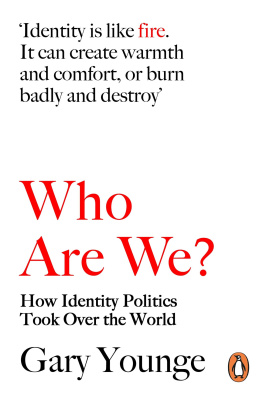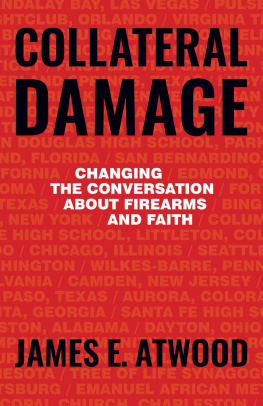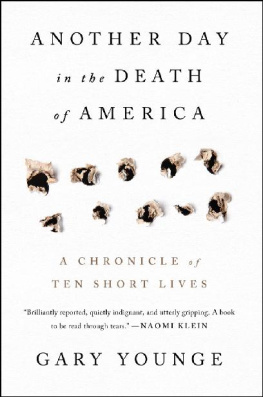
ALSO BY GARY YOUNGE
The Speech: The Story Behind Dr. Martin Luther King Jr.s Dream
Who Are WeAnd Should It Matter in the 21st Century?
Stranger in a Strange Land: Encounters in the Disunited States
No Place Like Home: A Black Britons Journey Through the American South

Copyright 2016 by Gary Younge
Published by Nation Books, an imprint of Perseus Books, LLC.,
a subsidiary of Hachette Book Group, Inc
116 East 16th Street, 8th Floor
New York, NY 10003
Nation Books is a co-publishing venture of the Nation Institute and the Perseus Books Group
All rights reserved. Printed in the United States of America. No part of this book may be reproduced in any manner whatsoever without written permission except in the case of brief quotations embodied in critical articles and reviews. For information, address the Perseus Books Group, 250 West 57th Street, 15th Floor, New York, NY 10107.
Books published by Nation Books are available at special discounts for bulk purchases in the United States by corporations, institutions, and other organizations. For more information, please contact the Special Markets Department at the Perseus Books Group, 2300 Chestnut Street, Suite 200, Philadelphia, PA 19103, or call (800) 810-4145, ext. 5000, or e-mail .
Library of Congress Cataloging-in-Publication Data
Names: Younge, Gary, author.
Title: Another day in the death of America: a chronicle of ten short lives / Gary Younge.
Description: New York: Nation Books, [2016] | Includes bibliographical references.
Identifiers: LCCN 2016014076| ISBN 9781568589763 (eBook) |
Subjects: LCSH: ViolenceUnited StatesCase studies. | Violent crimesUnited StatesCase studies. | Youth and violenceUnited StatesCase studies. | Firearms and crimeUnited StatesCase studies. | Firearms ownershipUnited StatesCase studies. | United StatesSocial conditions1980-| BISAC: SOCIAL SCIENCE / Violence in Society. | FAMILY & RELATIONSHIPS / Death, Grief, Bereavement. | POLITICAL SCIENCE / Public Policy / Social Policy.
Classification: LCC HN90.V5 Y675 2016 | DDC 303.60835dc23 LC record available at https://lccn.loc.gov/2016014076
First Print Edition
10 9 8 7 6 5 4 3 2 1
To Jaiden, Kenneth, Stanley, Pedro, Tyler,
Edwin, Samuel, Tyshon, Gary, and Gustin
for who you were and who you might have been.
You already know enough. So do I.
It is not knowledge we lack.
What is missing is the courage to understand
what we know and to draw conclusions.
SVEN LINDQVIST,
Exterminate All the Brutes
Table of Contents
Guide
CONTENTS




THE MOST COMMON ADJECTIVE EMPLOYED BY WEATHER REPORTERS on Saturday, November 23, 2013, was treacherous. But in reality there was not a hint of betrayal about it. The day was every bit as foul as one would expect the week before Thanksgiving. A Nordic outbreak of snow, rain, and high winds barreled through the desert states and northern plains toward the Midwest. Wet roads and fierce gusts in northeast Texas forced Willie Nelsons tour bus into a bridge pillar not far from Sulphur Springs in the early hours, injuring three band members and resulting in the tours suspension. With warnings of a five hundredmile tornado corridor stretching north and east from Mississippi, the weather alone killed more than a dozen people. And as the storm front shifted eastward, so did the threat to the busiest travel period of the year, bringing chaos so predictable and familiar that it has provided the plot line for many a seasonal movie.
There was precious little in the news to distract anyone from these inclement conditions. A poll that day showed President Barack Obama suffering his lowest approval ratings for several years. That night he announced a tentative deal with Iran over its nuclear program. Republican Senate minority whip John Cornyn believed that the agreement, hammered out with six allies as well as Iran, was part of a broader conspiracy to divert the public gaze from the hapless rollout of the new health care website. Amazing what WH will do to distract attention from O-care, he tweeted. Not surprisingly, another of the days polls revealed that two-thirds of Americans thought the country was heading in the wrong direction. That night, Fox News was the most popular cable news channel; The Hunger Games: Catching Fire was the highest-grossing movie; and the college football game between Baylor and Oklahoma State was the most-watched program on television.
It was just another day in America. And as befits an unremarkable Saturday in America, ten children and teens were killed by gunfire. Like the weather that day, none of them would make big news beyond their immediate locale, because, like the weather, their deaths did not intrude on the accepted order of things but conformed to it. So in terms of what one might expect of a Saturday in America, there wasnt a hint of betrayal about this either; its precisely the tally the nation has come to expect. Every day, on average, 7 children and teens are killed by guns; in 2013 it was 6.75 to be precise. Each individual death is experienced as a family tragedy that ripples through a community, but the sum total barely earns a national shrug.
Those shot on any given day in different places and very different circumstances lack the critical mass and tragic drama to draw the attention of the nations media in the way a mass shooting in a cinema or church might. Far from being considered newsworthy, these everyday fatalities are simply a banal fact of death. They are white noise set sufficiently low to allow the country to go about its business undisturbed: a confluence of culture, politics, and economics that guarantees that each morning several children will wake up but not go to bed while the rest of the country sleeps soundly.
It is that certainty on which this book is premised. The proposition is straightforward. To pick a day, find the cases of as many young people who were shot dead that day as I could, and report on them. I chose a Saturday because although the daily average is 6.75, that figure is spread unevenly. It is over the weekend, when school is out and parties are on, that the young are most likely to be shot. But the date itselfNovember 23was otherwise arbitrary. Thats the point. It could have been any day. (Were I searching for the highest number of fatalities, I would have chosen a day in the summer, for children are most likely to be shot when the sun is shining and they are in the street.)
There were other days earlier or later that week when at least seven children and teens were shot dead. But they were not the days I happened to choose. This is not a selection of the most compelling cases possible; it is a narration of the deaths that happened. Pick a different day, you get a different book. Fate chose the victims; time shapes the narrative.












